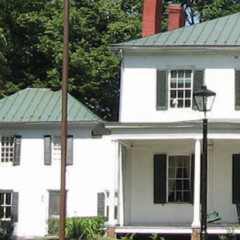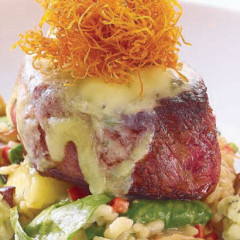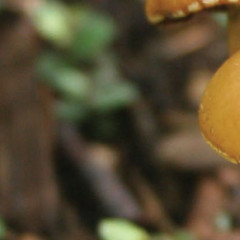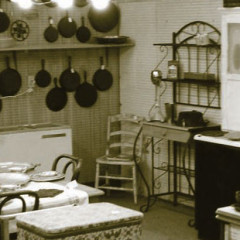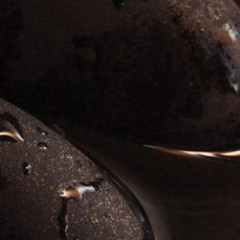Boydville – A Martinsburg gem since 1812
by Tricia Lynn Strader A large, white stately home has stood on South Queen Street in Martinsburg for over 200 years. Boydville is a late Georgian style mansion built in 1812 by Elisha Boyd, an attorney and member of the Virginia House of Delegates. He was an officer of the Fourth Virginia Regiment in the War of 1812. One cannot help being impressed when spying the large home that sits well back from the road with a long treelined drive. Boyd owned portions of the area in the 1790s, and Boydville is part of the Boydville Historic District area of Martinsburg that was developed for the well-to-do residents at the turn of the 20th Century. The district runs generally along South Queen Street to south of the Downtown Martinsburg Historic District and to east of the Boomtown Historic District. On Boyd’s death in 1841, his daughter Mary inherited. She was the wife of Charles J. Faulkner (1806-1884). Faulkner, like his father-in-law, was a member of the Virginia House of Delegates (1829-1834; 1848-1849) and Virginia Senate (1838-1842). He’d advocated a gradual abolition of slavery, and the forcible annexation of Texas from Mexico. He served as ambassador to France in the James Buchanan administration from 1859- 1861. Faulkner was an assistant adjutant general to Thomas J. “Stonewall” Jackson during the Civil War. Faulkner was temporary president of the West Virginia Constitutional Convention of 1872. He served in the West Virginia House of Delegates from 1875-1877. During the Civil War, Boydville and two other houses were marked for burning by Union General David Hunter in retaliation for the burning of Maryland Governor Bradford’s house. On an hour’s notice Mary Faulkner obtained an exemption from Abraham Lincoln, saving the house. The Faulkners’ son, Charles J. Faulkner II (1847-1929), was 15 when he fought in the Battle of New Market, Va., as a VMI cadet during the Civil War. He later became an attorney at 21 years old and a United States Senator from West Virginia. He liked to drink mint juleps and entertain at Boydville. The two story stucco-covered stone mansion consists of a main wing with nine rooms, a right wing, and a left wing that housed the kitchens. Today’s kitchen still has the call box, used by the family to ring a bell somewhere in the house and call the servants. The center-hall main house retains its original woodwork, with hand-carved door frames and mantelpieces imported from England. All three chandeliers in the front rooms were imported from France. The two parlor fixtures are the same, but the one in the foyer has falcons on it and was a gift from...
Cooking for a Cause
A Tale of Food and Philanthropy By Victoria Kidd For many, there are few passions in life that are more complete and consuming than the love of food. Combine that passion with a sincere drive to do good for the community, and you have the beginnings of something innovative and incredible. Hollywood Casino at Charles Town Races Executive Chef Brian Collins is one of those people with passion in equal parts for food and doing good. His passions have been the driving force behind a new cookbook developed to showcase great food while benefiting the United Way of the Eastern Panhandle (UWEP). Cooking for a Cause will be available sometime in late March or early April. This high-quality, hardcover book is unlike the seemingly standard-issue fundraising cookbooks which are familiar to most. At just over eighty full-color pages, the book is a beautiful presentation filled with delicious recipes and stunning photographs that are sure to ignite the reader’s desire to get in the kitchen and cook! While the book’s content is compelling in its own right, the story behind how and why it was produced makes this publication something truly special. As part of an undergraduate degree program, Chef Collins was asked to complete a business plan. It was an interesting assignment for someone in his line of work, but he decided to use his love of food and his love of helping the community as the foundation for the plan. His business plan detailed how he would go about creating a cookbook that would benefit a nonprofit. “I invested a lot of time in the project,” Collins says. “After it was complete, I thought I had something, and I shared the plan with my vice president.” Since the casino’s “house charity” is the United Way of the Eastern Panhandle, the idea of supporting the funding needs of the United Way while exposing the public to the culinary talents of Collins and his staff created excitement among management. Once Around The Panhandle Publisher Mike Hornby and photographer Bill Schilling signed on to provide their services voluntarily to the cookbook, the project was officially launched. Collins says, “Mike and Bill, along with so many others, have been instrumental to this project. It has been amazing to see how many people have invested so much time to support the United Way through this book.” Collins relays that it cannot be understated that this project was an undertaking that required a significant investment of time from the project contributors. “I myself know that I’ve got thousands of hours in this book. It has been a lot of work, but it really has...
A Fungus Among Us
by Mary Stickley-Godinez I have a new garden hobby. I love mushrooms. Those “gourmet” varieties, Oyster and Shiitake, are especially fun to cook with. It’s amazing how one of these can uplift a simple omelet into a culinary work of art. But having seen the cost of these in the grocery store, I decided to try my hand at growing my own. My first version was a predesigned kit that was an unassuming plastic bag stuffed with straw. A set of instructions said I was to poke holes in the bag, soak it for several hours in a bucket of warm water, and then set it in a humid location loosely covered with another bag which they provided. Surprisingly, I followed the instructions exactly and like magic, several weeks later each hole was just stuffed with sprouting mushrooms. And I was hooked. I have gotten several versions of these premade kits and they were all easy, almost stupid proof, and provided quite a number of tasty mushrooms. The flavor was definitely much better than what I was buying from the store. And when I figured out the cost of the kit, it was also far less expensive as long as I harvested them according to the directions. I do recommend that any mushroom hobbyist start with a kit so they are familiar with the appearance and flavor of a particular mushroom before trying to farm them on your own. All mushrooms are the fruiting body of a fungus of some type. They produce spores for the fungus to reproduce. Thus, the mushroom you see is but a small part of the overall organism. These fungi are all designed to decompose a particular type of organic material. Nor do they transfer to a different type of composting medium. So they may grow on straw, manure, wood chips, wood logs, and there are several wild types which grow on we don’t know what. In general, a fungus needs to have a moist or humid environment, so your medium needs to stay moist or humid. This can be a damp spot in the shade or a sprinkler set to go off every so often. I also found the undersides of the shelves in my greenhouse to be perfect for several types. Even a clear plastic trash bag might work — as in that first kit I bought. They also grow in different temperatures. Unless you have a temperature-controlled growing house, you will harvest the various species at specific times of the year and they will go dormant during the rest of the year. To grow your own, you need to gather the...
Antique, Vintage, Collectible… or Just Old?
Tips on the antiques trade by Bill Bowen If you cruise the ads on Craigslist, the auctions on Ebay, or any one of many, many other sites on the Internet, you will see the same item described as antique, vintage, collectible or old. To be perfectly accurate, the traditional definition of what constitutes an antique is something of artistic value 100 years old or older. In the U.S., that definition dates to the Smoot Hawley Tariff Act of 1930. This presently means that furniture or decorator items dating to 1914 would be considered antique. Over the years, the term “antique” has been so overly used that most people will use the term to describe anything “old.” While most of what my dealers and I sell don’t fit the Smoot Hawley Tariff Act definition (1914 or earlier), they do fit into the other categories or descriptions that have become, incorrectly, synonymous with antiques. Those two words are “collectible” and “vintage.” 1. Understand the difference between a true antique and the more commonly used collectible or vintage item. And just because something is old does not mean it should have a premium price associated with it. From Wikipedia: An antique (Latin: antiquus; “old,” “ancient”) is an old collectible item. It is collected or desirable because of its age, beauty, rarity, condition, utility, personal emotional connection, and/or other unique features. It is an object that represents a previous era or time period in human society. Note the above reference to beauty, rarity, condition, etc. in this definition, because that is what differentiates something old, vintage or collectible. “Vintage” is generally the time period from 40 years ago to 99 years ago. Using that scale, items from around 1975 to 1915 can be classified as vintage. “Collectible” is a catch-all term. People collect everything from thimbles to furniture, from baseball cards to French porcelain. And people collect many things that are neither old, vintage or antique. Beanie babies, cabbage patch kids, Department 56 villages and hundreds of other recent items are collectible. So also, is a Fabergé Egg from Czarist Russia (pre-Soviet Union). But the Fabergé egg is a true antique (beauty, rarity, condition), while the Cabbage Patch doll is a recent collectible. So, let’s say you are walking the aisles of your favorite “antique” shop and you spot a really interesting piece of furniture that the dealer has marked “antique sideboard.” If it is truly an antique you have to do some research to see whether it should command the price being asked. It could be a really great sideboard that dates to the 1940s, in which case it should be marked...
Hand and Stone Massage and Facial Spa
Providing the stepping stones to better health and wellness by Sasha Braithwaite photos by Lauri Bridgeforth Winter and its stiff-necked bite has left, and it is now time for rebirth and rejuvenation as Spring digs her hands into the earth bringing forth life again. Many people see spring as a time to start over and bring positive changes into their lives and well-being. Massages are a great place to start by removing all of the stiffness, stress and toxins that accumulated in the body during those cold months. Massages are a great catalyst for improving overall health and spurring along lifelong wellness. In August 2013, Robert and Lisa Limoges opened Hand and Stone Massage and Facial Spa in Winchester, Va. The franchise based out of New Jersey now has about 145 spas across the United States and Canada. The Limoges’ spa is the third Hand and Stone in Virginia, and they are about to open their second in Haymarket, Va. Lisa, who was previously a dancer, would often get massages to relieve muscle soreness. After she quit dancing, she continued to get massages as part of her wellness regimen, however she had to travel long distances to the spa, and it became more of a stress inducer rather than a reliever. For two or three years, she and Robert had wanted to run their own business together, so she began doing research and stumbled upon the Hand and Stone franchise. It was the company’s philosophy of helping people that initially drew Lisa in and made her and Robert want to own their own Hand and Stone spa. “I really liked being a part of something that was growing and up and coming, as well as bringing a concept here to Winchester that was nowhere around,” Lisa says. “We’re very connected to the community. It’s important that our community grows and thrives and has all of the wonderful things that other communities have. It felt like we had the opportunity, and even sometimes the responsibility, to bring something like this here.” The Limogeses also appreciated the franchise’s methodology in professionalism, availability and affordability—the three key words of the company. Professionally, Lisa and Robert only hire therapists and estheticians who are fully licensed and insured, which is not always the case at many spas. Many people say they are massage therapists, but there are no licenses to back up their credibility. As for availability, Hand and Stone spas operate on longer hours, seven days a week in order to make themselves available to the working individual. Affordability is what really makes Hand and Stone stand out. Their prices are lower than...

